The Buddhist art lecture series entitled “Discovering India”, organized by Dharma Drum University Preparatory Office for training volunteers of arts, has started at 2 p.m. on November 8, at
Dharma
Drum
Mountain
Zhongshan
Practice
Center. 98 people from all walks of life and age groups signed in the course, during the time between October 9, when the advertisement started, and November 2, when the registration was due. In view of the classroom capacity, the Preparatory Office decided to receive 63 extra registrations for the lecture series originally designed for 35, to allow more people interested in Buddhist arts to participate.
The first lecture was given by Professor Lin Bao-Yao of the Graduate School of Art History,
Taipei
National
University of the Arts, on the sacred Buddhist sites in
India. Despite the sudden cold wet weather in
Taipei brought about by the Northeast monsoon, 52 participants didn’t hesitate to appear for the class, packing the classroom. Below are some photos taken in class.:
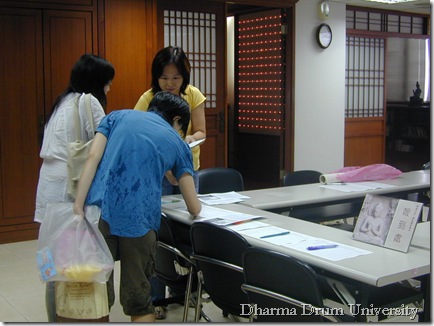 | Students come to class on a wet cold day. |
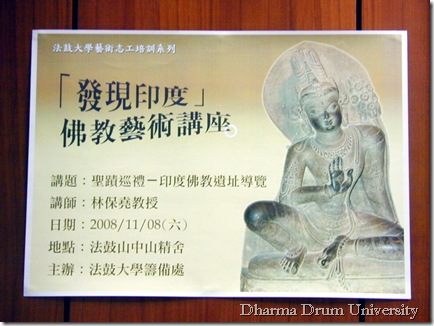 | Poster for the lecture at the classroom. Featured is a delicate statue of Mahāsthāmaprāpta Bodhisattva (Great Strength Bodhisattva) from
Bihar
Museum in
India. |
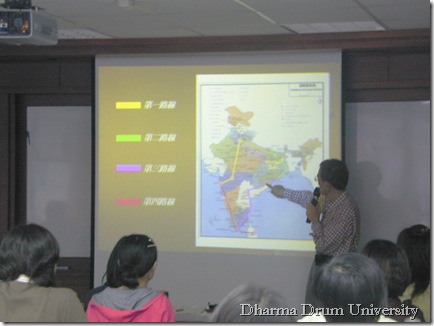 | Prof. Lin illustrating four routes for investigating the ancient Buddhist sites |
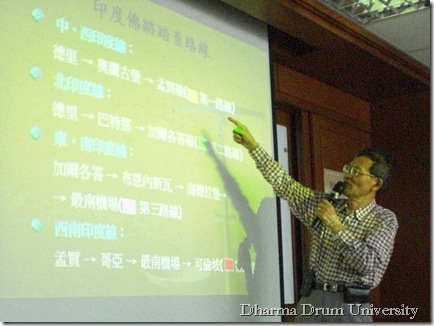 | The four routes of investigation: the mid and western route, the northern route, the southern and eastern route, and the southwestern route |
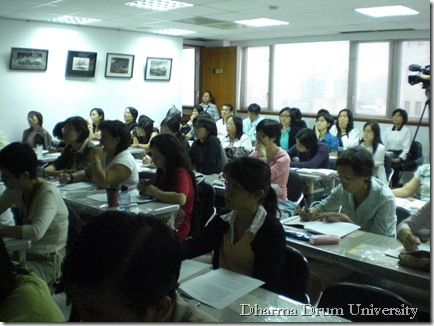 | Participants taking notes attentively |
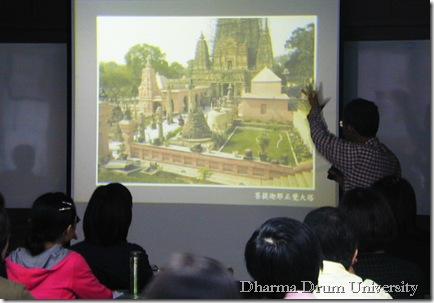 | The slide presentation of Mahabodhi Temple in Bodhgaya, where Shakyamuni Buddha realized ultimate enlightenment. King Akshoka of the Maurya Empire first built the temple, along with the Bodhimanda under the Bodhi Tree, after he paid his visit here. The site had been buried underground for several hundred years due to a flood in the 14th century, until Sir Alexander Cunningham, then Director General of the Archeological Survey of India, found and uncovered the site in 1861 according to a description in the Great Tang Records on the Western Regions, restoring it to its former glory. |
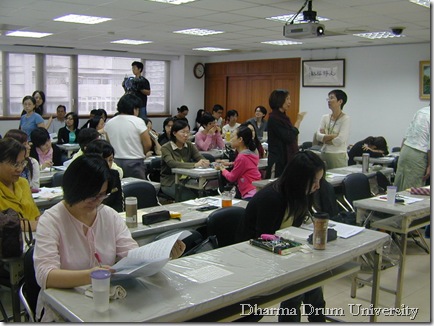 | Participants enjoying a guided tour transcending time and space by Prof. Lin |
 | Taking a break for 10 minutes—for a further more enjoyable tour |
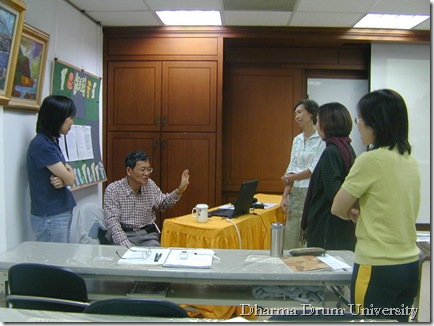 | Prof. Lin sharing his experiences of field investigation with interested participants during the break |
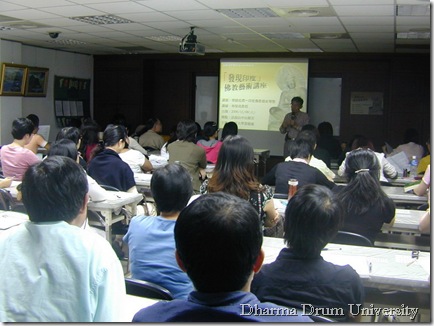 | Second half of the class continues at 15:50, in which Prof. Lin announces an imminent field expedition in January 2009, organized by the Preparatory Office for the participants to explore Buddhist arts. Entitled “Discovering India”, to be led by Prof. Lin, this trip will provide the participants with training experiences and opportunities to take field photos, which will be exhibited at the opening ceremony of the
Degui
Learning
Center in March 2009. When agreed upon, these field photos will likely be used as part of the University’s digital photographic archive of Buddhist arts, for teaching and research purpose. |
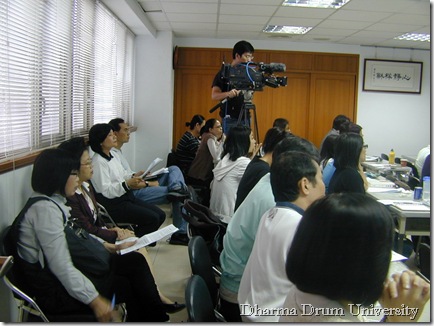 | The whole lecture series will be videoed, and shared with those who miss the opportunities to join in class through our e-Learning website |
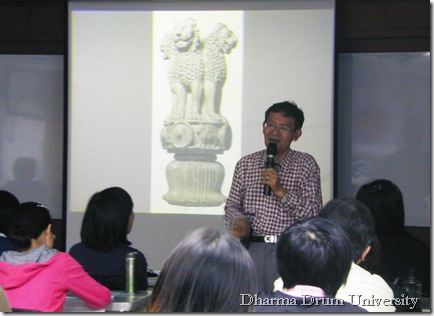 | The Mauryan king Akshoka erected a series of some 30 sandstone columns, known as the “Akshoka pillars”, throughout his kingdom to mark his reign and his support for Buddhism. The slide shows the representative lion capital of the Akshoka pillars. Carved in 242-232 B.C., 2.13 meters high, this sculpture was excavated in Sarnath (Where the Buddha’s first sermon took place) in 1904 and is considered one of the most extraordinary items among early Buddhist artworks. It is now stored in
Sarnath
Archaeological
Museum. The pillars average some 12.8 meters high. This Akshoka pillar has collapsed and is mutilated, its ruins still remains in the same location. |
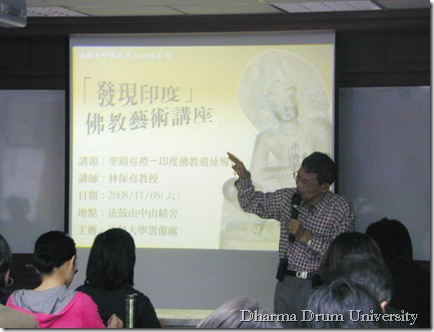 | At the end of the lesson, Prof. Lin encourages the participants to pay a salute to the ancient Buddhist sacred sites in India on foot as a way of spiritual practice, experiencing the “walking culture”, a walking practice originated in ancient India, instead of being indulged in sitting meditation now so popular in
Taiwan, dubbed by Prof. Lin as the “butt culture”. |
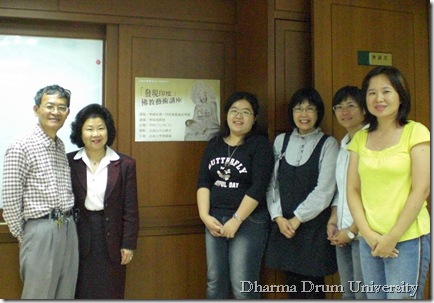 | A photo session with Prof. Lin and his wife after class. From left to right: Prof. Lin Bao-Yao, Wu Xiao-Mei (Prof. Lin’s wife), Yan Qi-Ying, Academic Development Department of the Dharma Drum University Preparatory Office, Zhou Ying-Lian (flower arrangement teacher, a sit-in participant), Dai Yu, lecture series assistant, and Lin Shan-Yu, secretary of Dharma Drum University Preparatory Office |
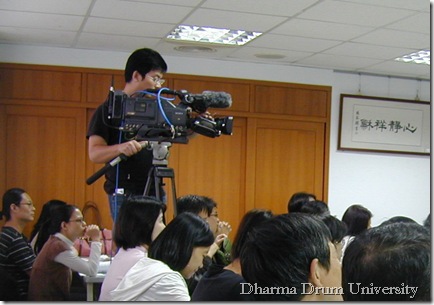 | Special thanks to the supportive filming team from Dharma Drum Mountain Cultural Center |
Photography and filming by Chen Xiu-Hui and Dai Yu
Content by Chen Xiu-Hui















